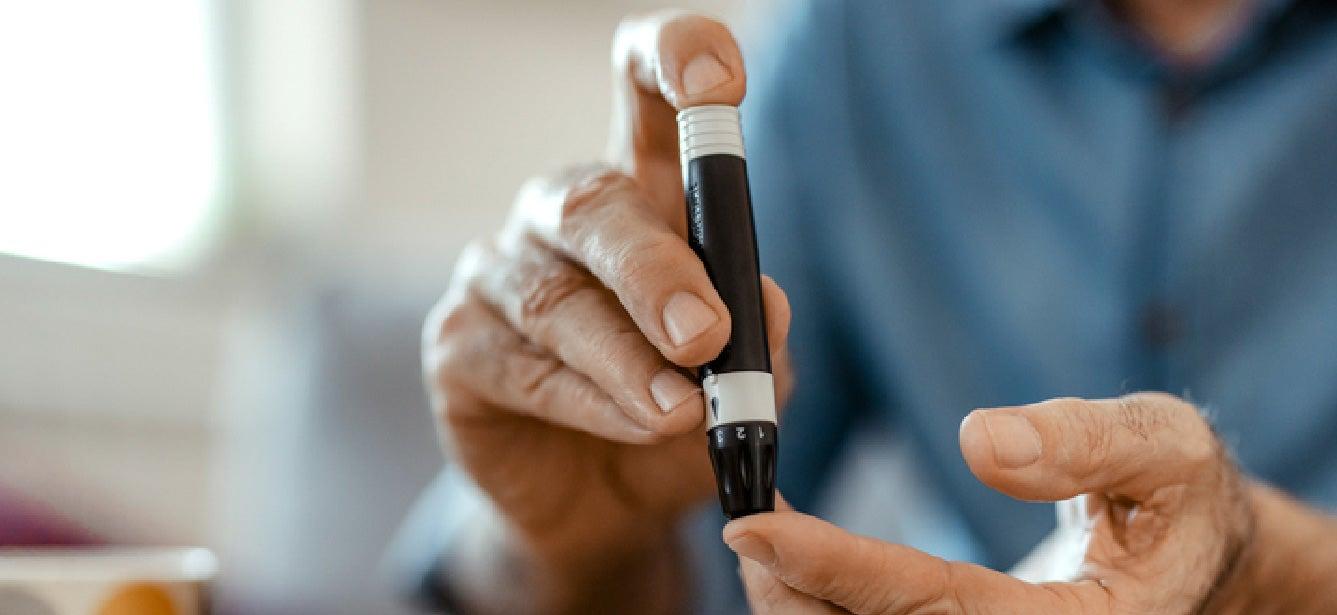
Related Topics
It may be easy to dismiss regular fatigue or vision problems as signs of aging. But when these symptoms are coupled with constantly feeling thirsty or strange sensations in your hands and feet, they could be signs of diabetes. The earlier you catch your symptoms, the better you can manage a disease that, if untreated, can derail your quality of life.
What is diabetes?
Diabetes is a chronic disease that occurs when your body doesn’t produce enough insulin, or any at all. Insulin is a hormone your pancreas makes to help you change blood sugar, known as glucose, into energy from the food you eat.1 Without insulin, too much glucose builds up in your blood, leading to the following health issues:1
- Heart disease
- Kidney disease
- Stroke
- Eye health issues, such as vision loss and blindness
- Nerve damage
Over 38 million people in the U.S. have diabetes and nearly 30% of adults age 65 and older are diabetic, according to the American Diabetes Association.2 There are different types of diabetes that come with their own risk factors.
What types of diabetes are there?
The most common types of diabetes include:
- Type 1 diabetes. People with type 1 diabetes cannot develop any insulin at all because of an autoimmune response, which means their body mistakenly tells their pancreas to stop making it. While most people with type 1 diabetes are diagnosed as children, teens or young adults, it can still occur at any age.3 Older adults diagnosed in their youth are living longer, and today half of all new diagnoses happen after age 20.4 In addition to age, other risk factors for type 1 diabetes include:5
- Having a parent or sibling with type 1 diabetes
- Genetics
- Type 2 diabetes. This is the most common type of diabetes, especially in older adults.1 People with type 2 diabetes can’t develop enough insulin or use insulin well enough to control their glucose levels. The difference between type 1 and type 2 diabetes is that type 2 diabetes is preventable with regular exercise and a healthy diet.6 Type 2 diabetes risk factors include:7
- Having a parent or sibling with type 2 diabetes
- Being overweight
- Being age 45 and older
- Not engaging in regular physical activity
- Smoking
- Regular heavy use of alcohol
- Identifying as Black, Hispanic, Latino, American Indian, Alaska Native, Pacific Islander or Asian American
There are also two conditions that are risk factors for type 2 diabetes: prediabetes and gestational diabetes.
Prediabetes occurs when your glucose levels get dangerously high, but not high enough to trigger type 2 diabetes.8 Like type 2 diabetes, prediabetes is also preventable with healthy eating and exercise.
Gestational diabetes can occur during pregnancy and usually goes away after a baby is born. However, it can increase a person’s chance of developing Type 2 diabetes in the future.6 Some risk factors include prediabetes, being overweight, and inactivity.9
What are the early signs of diabetes?
Some symptoms of diabetes develop slowly over time. You should make an appointment with a health care provider if you regularly experience any of the following warning signs:10
- Increased thirst
- Increased hunger
- Rapid weight loss
- Exhaustion
- Frequent urination
- Blurry vision
- Numbness or tingling in feet or hands
- Headaches
- Slow-healing cuts and bruises
- Fainting
- Dizziness
- Red or swollen gums
- Dry mouth
How do you know if you have diabetes?
To get an official diagnosis, your health care provider may give you a series of blood tests to measure your glucose levels.
Examples of how to test for diabetes include:11
- A1C test. An A1C test measures your average glucose levels over three months. A glucose level of 6.5% or higher may indicate diabetes. Any level between 5.7% and 6.4% may signal prediabetes.
- Fasting blood sugar test. A doctor may test your glucose levels after you’ve fasted, which means not eating in the last eight to 12 hours. You may have diabetes if your glucose level is 126 mg/dL or higher.
- Glucose tolerance test. A glucose tolerance test compares your glucose levels after you fasted as many as 12 hours to your levels after drinking a glucose liquid. After drinking the glucose liquid, a health care provider will test your glucose levels periodically over three hours. Any level 200 mg/dL or higher could mean you have diabetes.
- Random blood sugar test. A health care professional will measure your blood sugar on the spot without asking you to fast first. A glucose level of 200 mg/dL or higher could signal diabetes.
How do I manage diabetes?
Diabetes care management takes work, but you can live a healthy and active life with diabetes if you stay on top of your health and well-being in the following areas:
Medical care
A doctor may prescribe you multiple medications to help manage your diabetes that fall under these categories:
- Insulin: Insulin medication converts glucose in your blood into energy. It is often taken as a needle injection, but it can be inhaled.12 There are different types of insulin a doctor could prescribe based on factors such as your age, physical activity and what you eat.
- Oral drugs: There are many diabetes medications you can take by mouth that help lower your glucose levels. The most common diabetes medication is metformin, which reduces the glucose your liver makes and makes it easier for your body to use insulin.13 Medicare, a federal health insurance program for adults age 65 and older, covers medications for diabetes, including insulin. Under Medicare, you will pay no more than $35 per month. Medicare covers diabetes education to help you learn how and when to administer insulin. It also covers any equipment or supplies you may need to take insulin, tests to measure your glucose levels, and special footwear to alleviate any nerve pain.14 Your doctor may have to write prescriptions for these services, so it’s important to make sure you are following Medicare rules for management care.
Healthy eating
When managing your diabetes, it’s important to eat a balanced diet of foods that will not spike your glucose levels. This means limiting or steering clear of food and drinks loaded with sugar in favor of lean proteins, healthy fats and carbohydrates filled with vitamins, fiber and minerals.15 Because the starch and sugars in carbohydrates, or “carbs,” can raise your glucose, it’s best to eat nutrient-rich ones like broccoli or green beans to keep your glucose levels from rising quickly.16
Using a plate that is 9” in diameter, the Centers for Disease Control and Prevention recommends using one half for non-starchy vegetables, such as broccoli or carrots. Split the other half of the plate with lean proteins like nuts and fish, and carbohydrates like whole grain pasta and beans. Stick with water as a beverage, or drinks that are low in calories and sugar.16
In addition to scaling back on sugary foods and drinks, it’s best to avoid or limit processed foods, such as pre-packaged TV dinners, fried foods like French fries, and high-fat dairy and meats such as bacon and butter.15
The American Diabetes Association has resources for people looking for healthy meal tips. Your health care provider can also connect you with a registered dietitian or nutritionist to map out a healthier diet.
Physical activity
Getting 150 minutes a week of moderate-intensity exercise can keep your glucose levels under control.17 It also helps reduce your bad cholesterol, high blood pressure and your weight.17
Older adults can get in a workout from activities such as:18
- Dancing
- Walking
- Lifting weights
- Yoga
- Bike riding
- Swimming
You can break up the 150 minutes however you want. The important thing is to get your blood pumping. But don’t go too hard at first. Start slowly and work your way up to a higher intensity workout. Your health care provider can also tell you what kinds of physical activity are best for you. Many senior centers and other community centers offer physical activity programs that are fun, engaging, and help you get the recommended 150 hours per week of exercise. Learn more about best physical activities for people with diabetes.
How can I prevent diabetes?
There is no way to prevent type 1 diabetes. However, there are lifestyle changes you can make to prevent type 2 diabetes.
Because most type 2 diabetes cases begin with prediabetes, it’s important to test your glucose levels, which can be done with regular check-ups with your primary care doctor. If you have risk factors for diabetes described above, reducing the risk factors is vitally important in preventing diabetes.
If your glucose levels indicate prediabetes, here are some steps you can take to reverse course:19
- Make a weight loss goal
- Follow a healthy eating plan
- Get more physical activity
- Keep track of your progress
The Centers for Disease Control and Prevention’s National Diabetes Prevention Program offers help with all of these steps through its lifestyle change programs. You can search for programs near you to get in-person or virtual advice from experts about staying healthy. Before making any lifestyle changes, remember to keep your health care providers in the loop about your health and wellness plans.
Sources
1. National Institute on Aging. Diabetes in Older People. Found on the Internet at https://www.nia.nih.gov/health/diabetes/diabetes-older-people
2. American Diabetes Association. Statistics About Diabetes. Found on the Internet at https://diabetes.org/about-diabetes/statistics/about-diabetes
3. Cleveland Clinic. Type 1 Diabetes. Found on the Internet at https://my.clevelandclinic.org/health/diseases/21500-type-1-diabetes
4. American Diabetes Association. Diabetes Type Confusion. Found on the Internet at https://www2.diabetes.org/diabetes/newly-diagnosed/diabetes-type-confusion
5. Mayo Clinic. Type 1 diabetes. Found on the Internet at https://www.mayoclinic.org/diseases-conditions/type-1-diabetes/symptoms-causes/syc-20353011
6. Centers for Disease Control and Prevention. What is Diabetes? Found on the Internet at https://www.cdc.gov/diabetes/basics/diabetes.html
7. Centers for Disease Control and Prevention. Diabetes Risk Factors. Found on the Internet at https://www.cdc.gov/diabetes/basics/risk-factors.html
8. Centers for Disease Control and Prevention. Prediabetes – Your Chance to Prevent Type 2 Diabetes. Found on the Internet at https://www.cdc.gov/diabetes/basics/prediabetes.html
9. Mayo Clinic. Gestational diabetes. Found on the Internet at https://www.mayoclinic.org/diseases-conditions/gestational-diabetes/symptoms-causes/syc-20355339
10. Mayo Clinic. Diabetes symptoms: When diabetes symptoms are a concern. Found on the Internet at https://www.mayoclinic.org/diseases-conditions/diabetes/in-depth/diabetes-symptoms/art-20044248
11. Centers for Disease Control and Prevention. Diabetes Tests. Found on the Internet at https://www.cdc.gov/diabetes/basics/getting-tested.html
12. Centers for Disease Control and Prevention. Types of Insulin. Found on the Internet at https://www.cdc.gov/diabetes/basics/type-1-types-of-insulin.html
13. Cleveland Clinic. Oral Diabetes Medications. https://my.clevelandclinic.org/health/articles/12070-oral-diabetes-medication
14. National Council on Aging. Diabetes and Medicare. Found on the Internet at https://www.ncoa.org/article/diabetes-and-medicare
15. National Council on Aging. Why It's Important to Eat Healthy When You Have Diabetes. Found on the Internet at https://www.ncoa.org/article/why-its-important-to-eat-healthy-when-you-have-diabetes
16. Centers for Disease Control and Prevention. Diabetes Meal Planning. Found on the Internet at https://www.cdc.gov/diabetes/managing/eat-well/meal-plan-method.html
17. American Diabetes Association. Anaerobic Exercise and Diabetes. Found on the Internet at https://diabetes.org/health-wellness/fitness/anaerobic-exercise-diabetes
18. National Council on Aging. The 6 Best Activities for Older Adults with Diabetes. Found on the Internet at https://www.ncoa.org/article/the-6-best-activities-for-older-adults-with-diabetes
19. National Institute on Aging. Diabetes in Older People. Found on the Internet at https://www.nia.nih.gov/health/diabetes/diabetes-older-people



